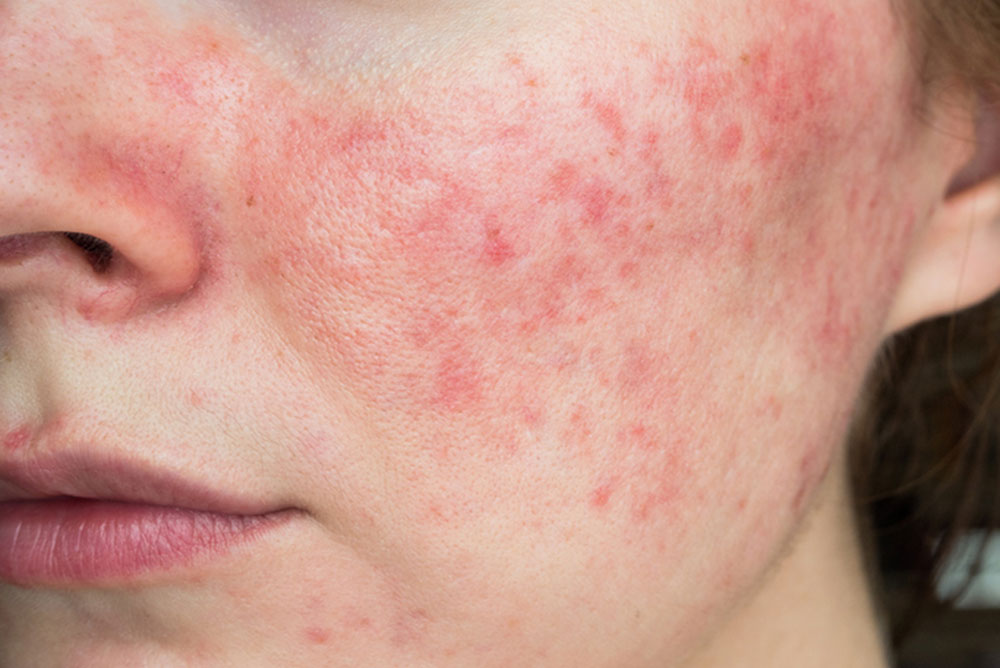
iStock
By Mary Carpenter
DC GRANT-WRITER CC had mostly ignored the flushed redness of her cheeks until her five-year-old granddaughter, sitting in her lap one day, asked “What are those red spots?” That comment sent CC to a dermatologist who diagnosed rosacea, a chronic inflammatory condition that progresses with sun exposure and age. Famous sufferers include Bill Clinton and W.C.Fields, but according to the Mayo clinic, rosacea is most “common in middle-aged women.”
After one or two bouts of rosacea—often in high-stress situations—some people never have another, but it can be important to keep track. Over time, redness and flushing “may cause small blood vessels in the face to enlarge permanently and become more visible through the skin..like tiny red lines (called telangiectasias),” writes Southern California dermatologist Gary Cole. Continued or repeated episodes of flushing may also promote inflammation, causing small bumps or leading to overgrowth of tissues that appear as a thickening and permanent swelling.
Rosacea usually occurs in flare-ups every few weeks or months, tending to get worse over time and set off by triggers—both environmental and lifestyle, but these can be complicated. Heat, for example, is a trigger, and while hot, sunny days can increase the risk of dehydration, that is not itself a trigger—but staying hydrated can help reduce symptoms.
People living in cities have more frequent flare-ups than those living in the countryside— considered both “environmental” and “lifestyle.” Spicy foods are common triggers as are specific ingredients like pepper and cinnamon. Many people cite alcohol as a trigger while others disagree, and many women report rosacea symptoms worsening with their hormonal cycle. But the most difficult-to-control trigger is stress.
While the cause of rosacea is unknown, it can run in families, commonly occurring in those with light skin of Northern European descent. Inflammation is part of the disease definition but may also play a role in its initial onset, due to an overactive immune system. And demodex mites — tiny parasites, which are very common in the skin of healthy individuals, but only in high numbers cause an array of symptoms requiring treatment — are often present in those with rosacea.
Of the four types of rosacea symptoms, the two that most often occur in combination are type 1 —red areas on the face, sometimes accompanied by small, visible blood vessels; and type 2— papules and pustules (bumps and puss-filled spots) that can look like pimples.
The inflamed eyes and eyelids that characterize a third rosacea type occur in up to 50% of sufferers. Eye symptoms range from the most common, mild dryness and irritation, to blurred vision, recurrent infections and the rarer sight-threatening keratitis, according to German dermatologist Carolyn Hilbring and colleagues. A fourth type of rosacea involves thickened skin on the nose that can make it look large, bumpy and bulbus, called rhinophyma.
Because the causes of rosacea are poorly understood and symptoms vary widely, the list of treatments include a wide range of anti-inflammatories and antibiotics in both topical and pill form. For some people with a high number of mites, for example, a topical cream like ivermectin helps fight the mites and can reduce inflammation, while others need oral antibiotics like doxycycline.
The antibiotic metronidazole, applied topically, is a first-line treatment that kills bacteria to reduce inflammation. Other topical drugs like brimonidine work by constricting blood vessels, which decreases blood flow to the face to reduce flushing; and beta blockers, commonly used to treat high blood pressure, have a similar effect. Oral contraception has helped those women whose rosacea worsens with their menstrual cycle.
CC’s dermatologist recommended treatments with the pulsed dye Vbeam laser, which uses yellow light to target blood vessels—heating them and causing them to collapse and be reabsorbed by the skin—without damaging surrounding tissue, explains Florida-based dermatologist Kerry Shaughnessy.
For CC, one treatment “certainly got rid of the red veins and reduced the red spots on my cheeks. It didn’t totally remove the rosy color, but I am sure that if I went in more regularly, it would be more effective.” The first round usually involves several treatments three to six weeks apart, and after that another every year or two. But cost is a major drawback to the laser option: It costs around $500 per session, which is rarely covered by insurance.
For local filmmaker KL, red, elevated bumps became more noticeable over the years, but laser treatment was financially out of reach. Her dermatologist started her off with topical metronidazole, along with a sodium sulfacetamide and sulfur cleaner — “all of which had no effect at all,” KL said.
The next doctor recommended the antihistamine Zyrtec, which could help with her seasonal allergies and hopefully treat her skin at the same time, along with Benadryl cream. These helped at first with the rosacea but not for long, and now she’s headed for a third opinion— a trial-and-error path, common among rosacea sufferers.
While speaking in public, I have had facial redness intense enough to worry onlookers, along with more common symptoms like dry mouth and a rapid heartbeat. Beta blockers, recommended for anxious public speakers, seemed to help but made me sleepy. For my next event, I plan to try a cold-water face-dunk, known to set off the diving reflex, which can slow the breath and heart rate, quickly relieve stress and hopefully forestall future facial reactions.
—Mary Carpenter regularly reports on need-to-know topics in health and medicine.
